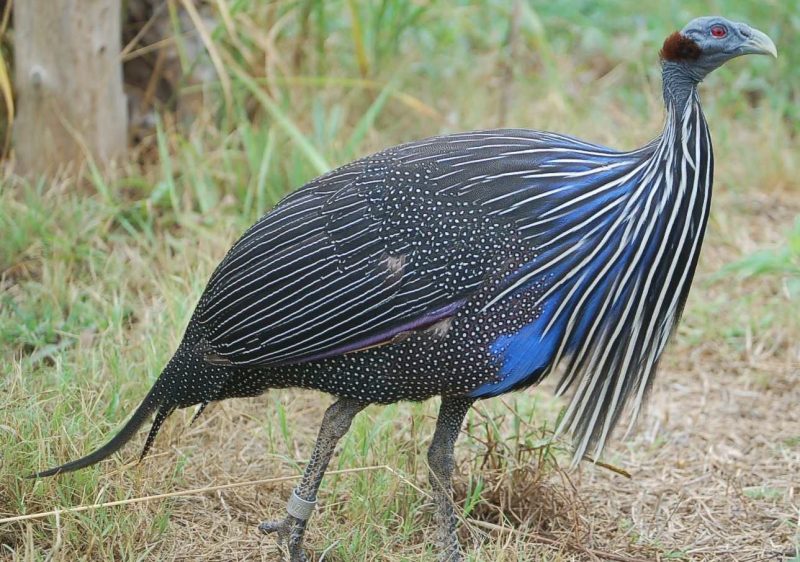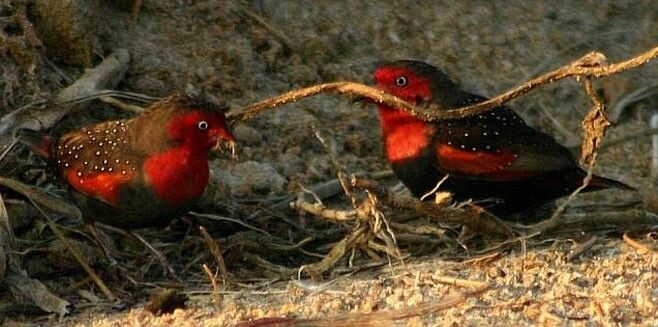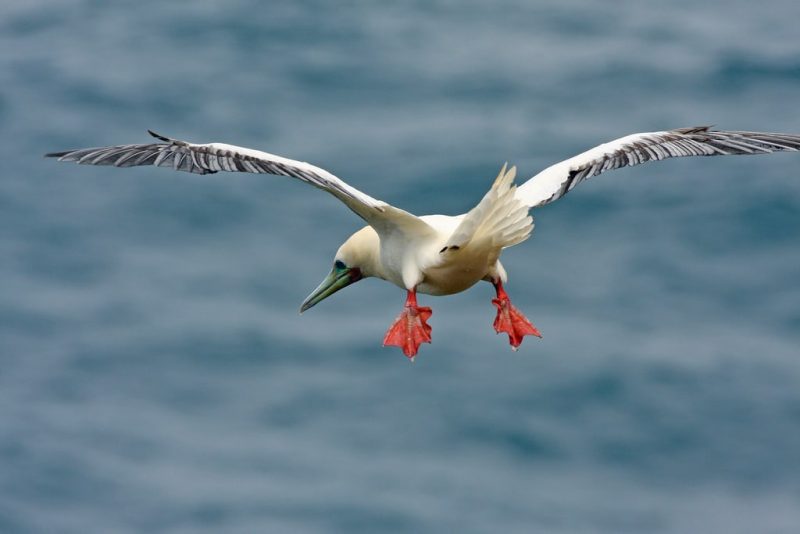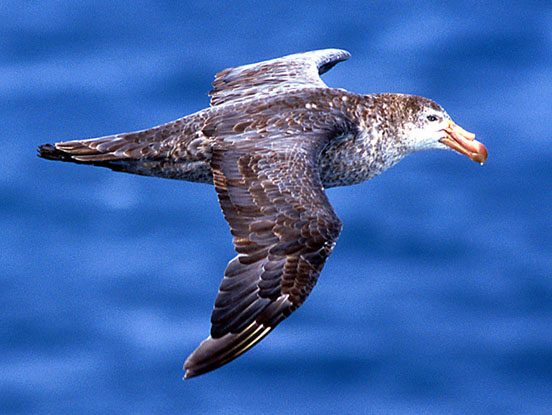The Vulturine Guinea Fowl of Kenya
The Vulturine guinea fowl inhabits much of Somalia, southern Ethiopia, Tanzania, and Kenya. It lives in flocks of 30 individuals in the savanna, dry bush, scrubs, acacia woodland, forest edges, and grassland with trees. Because guinea fowls are hardy birds, they are suitable for a range of climatic conditions. At night, the birds roost in trees. The call of the guinea fowl is like a high-pitched song. The International Union for Conservation lists the guinea fowl as a lower risk because its numbers appear to be stable throughout its distribution range.
Unique physical characteristics
What gave the bird its name is the appearance of bluish-gray colored bare skin of the upper neck and a head that is very similar to vultures. The lower rear neck shows some short, beautiful, white and black erected feathers. Wings and the tapered tail have the same pattern. The underwings show grayish-white flight feathers and spotted-white coverts. These feathers dance when it moves, giving it an elegant posture. The borders of the secondary flight feathers are lilac in color.
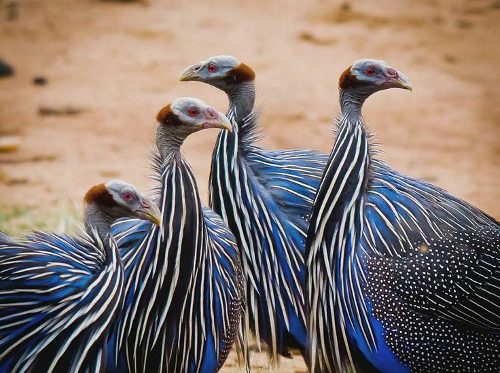
Vulturine guinea fowls in the wild Source: www.guinea-fowl.com
Lanceolate, elongated, black and white hackles overlay the cobalt-blue breast and back. The blue-cobalt color contrasts strongly with the black and dark gray body plumage with fine white spots. The male and female of Vulturine guinea fowls have similar plumage. But in size, the female is slightly smaller than the male. The bill is horn-colored and de-curved with a broad base, typical of the Galliformes species. The eyes are red, and the feet and long legs are dark gray.
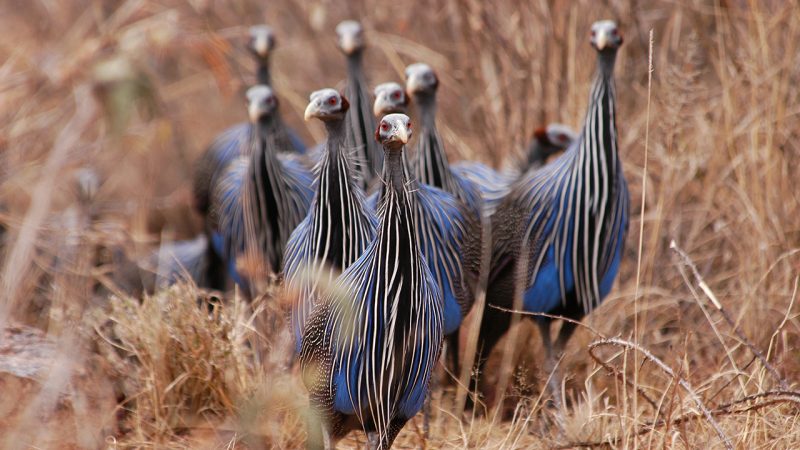
Vulturine guinea fowl
Wining and dining
Guinea fowls spend the day scraping the ground looking for food. They eat seeds, insects, tubers, and fallen fruits. Guinea fowls consume all non-conventional feeds and have excellent foraging capabilities. Hence, they are quick enough to grab a rodent or a small snake and can go for a long time without water.
Defense against threats
The main predators of guinea fowls are raptors. Monkeys steal their eggs and chicks. When confronted, these social birds are likely to run than fly but, when they take to the air, they are high fliers.
Raising in farms
Commercial farming of guinea fowl is at its nascent stage in Kenya but is generating a considerable amount of interest. Some people raise guinea fowls for their ornamental value. But they are mainly raised for their eggs and flesh. The meat is tender and nutritious with a flavor similar to other birds. It is lush and lean in essential fatty acids.
Best breeding practices
The reproduction season of guinea fowl starts at the onset of the rainy season. The birds that are breeding can be confined in houses or put on the free range during the laying period. Some breeders use artificial insemination where the birds are caged, and males are kept separately in cages. They mate in pairs if females and males in the flock are equal numbers. But higher fertility rates occur in flocks where the ratio of male and female is approximately one to 5 hens. Sometimes, domestic roosters cross with guinea hens. The chicks of such cross are sterile.
Laying of eggs
Guinea fowls lay eggs during the rains and few weeks that follow. They start to lay eggs in the 17th week. In the wild, females lay about twelve eggs in scrapes under small shrubs lined with grass. Guinea hens lay eggs for 6 to 9 months. In captivity, the period can be extended using artificial lighting.
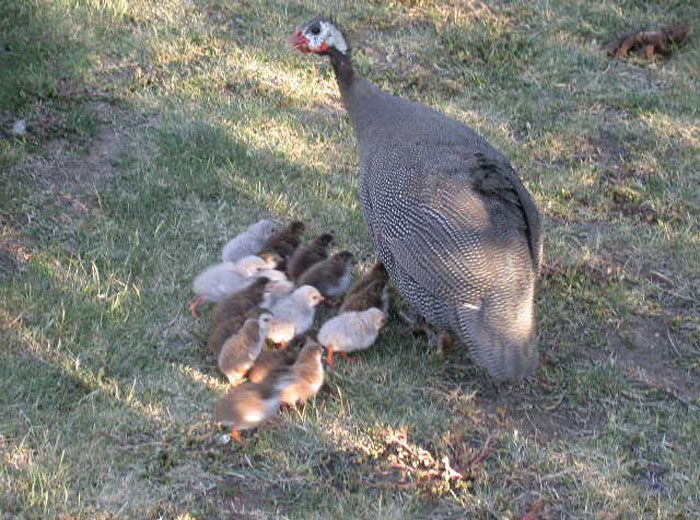
About guinea fowl Source: www.guineafowlforsale.com
Under proper management, a guinea hen reared on soil lays around 100 eggs whereas caged guinea hens lay as many as 180 eggs over a laying period of 40 weeks in a year. The hen can lay eggs for three years. Hatching eggs should be collected at least four times in a day. But under extreme conditions frequent collection is recommended. The eggs weigh 40g. The shells are hard making it difficult to test fertility by candling. The hard shell of the eggs of guinea fowls provides low keeping quality and minimum breakage. Poultry farmers hatch eggs either naturally or artificially.
Hatching eggs naturally
Because guinea hens are too wild, chicken hens hatch guinea eggs as they can be more adaptable. Such natural methods of incubation are perfect for small flocks. They need to be brooded for four weeks to avoid mortality. Guinea chicks are called keets. As soon as the guinea keets hatch and start to move about, the hen is likely to leave, abandoning the unhatched eggs. These eggs may hatch if they are placed under another hen or in an incubator. A single hen can hatch around 12 eggs. Hens should be treated for lice beforehand.
Hatching eggs artificially
For bigger flocks, incubators are the best. If artificial, they must be at a temperature of 15.5 to 18.50C. Forced-draft incubators must be at 370C and 58% humidity. Hatchability declines with increasing storage time. Turning the eggs regularly every day for 21 days for crossbreeds and 24 days for guineas is highly recommended. The incubation period for guinea eggs is 28 days, and the chicks fly after ten weeks.
Special keet diet
The starter diet for the chicks should contain 24% protein for the first four weeks, and 20% protein until eight weeks. The finisher diet should include 16% protein until market age. By then, they should have reached an average weight of 2 kg. The guinea fowl in its lifetime consumes 43 kilograms of feed. The nutritional characteristics are very close to those for chicken.
Easy but beware
Guinea fowls are either sold alive or dressed. The birds are ready for the market at 18 weeks of age. Guinea fowls do not require expensive and complicated housing. Moreover, domestic guinea fowls are usually resistant to pests, more tolerant to aflatoxin and mycotoxin and are not very susceptible to many diseases as compared to chickens. The only limitation is that the birds are noisy. And producers need to be sure of the demand before embarking on production.
Frequently Asked Questions About Vulturine guinea fowl
To receive a colourful digibook about birds with videos, images and text, please fill out the following form or simply email us on safaris@safari-center.com

